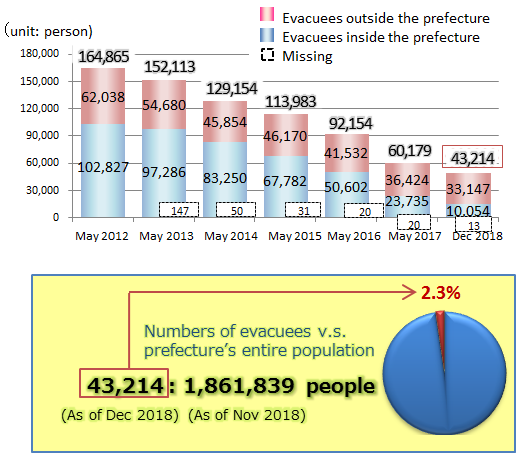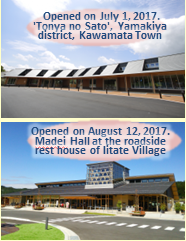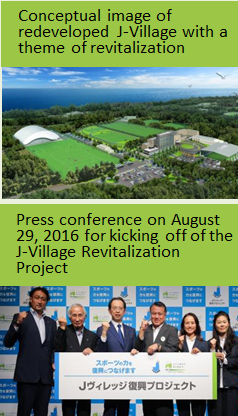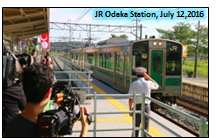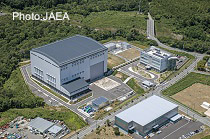See here for the latest information
Transition of the Evacuation-Designated Zones
"~Fukushima Today~Steps for Reconstruction and Revitalization in Fukushima Prefecture"
Transition of evacuation designated zones
Currently, the evacuation designeted zones (371km2) occupy 2.7% of areas of Fukushima Prefecture (13,783km2).
On April 01 2017, most of the evacuation orders issued to the evacution-designated zones (excluding the Difficult-to-Return zones) have been lifted.
The Difficult-to-Return zones have beeen recognized in the Plans for Reconstruction and Revitalization for Special Zones. Accordingly, reconstruction and revitalization even in the Difficult-to-Return zones are already showing steady progress with remediation and construction underway.
March 11, 2011
March 12, 2011
April 22, 2011
|
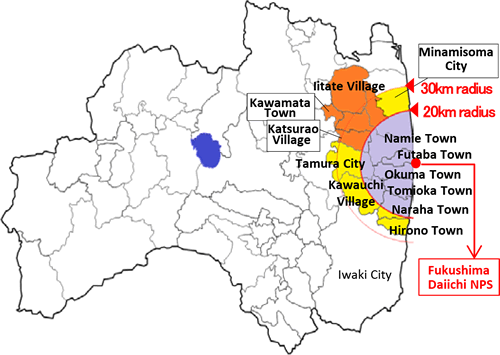 |
Current Instructions
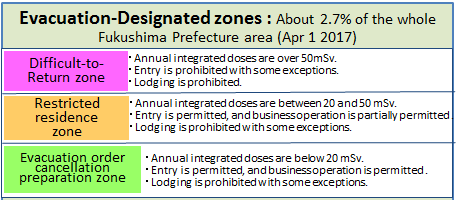
Transition
On 1 April 2017, the evacuation designated zones are approx. 2.7% occupation (371km2) of the entire area of Fukushima Prefecture (13,783km2).
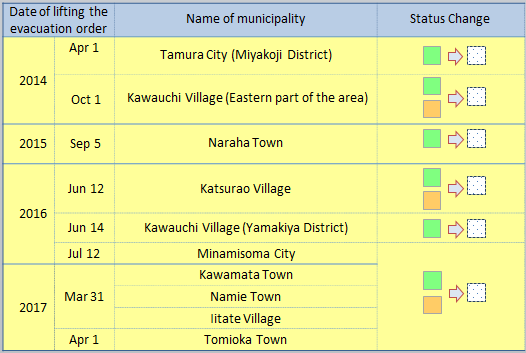
| 2015.9.05 | 2016.6.12 | 2017.3.10 |
|---|---|---|
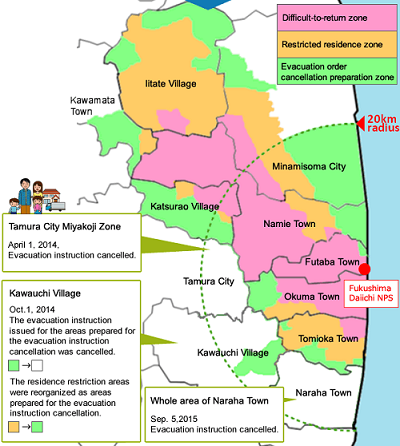 |
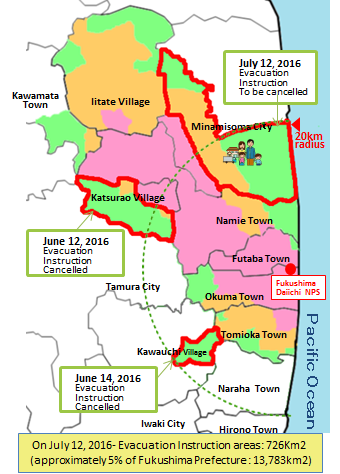 |
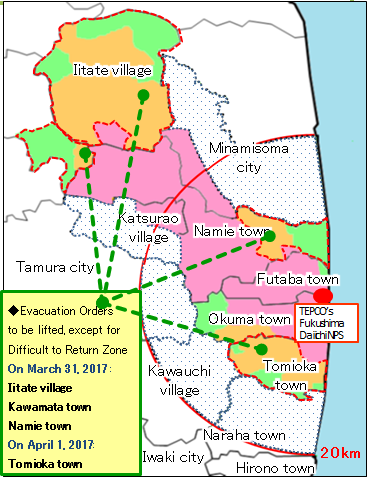 |
2017.4.01
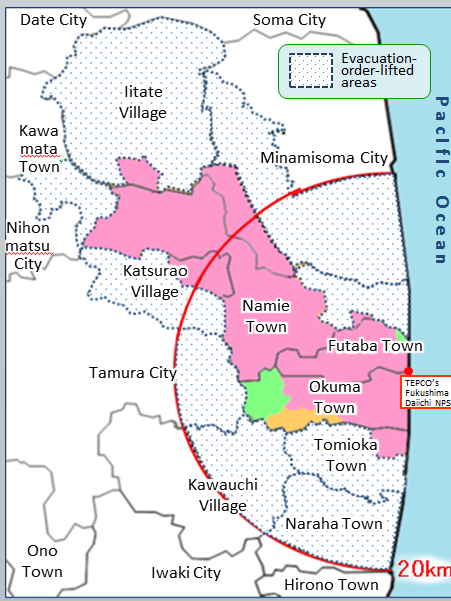
In the difficult-to-return zone
Following the revision of the Act for Special Measures for the Reconstruction and Revitalization of Fukushima (May, 2017), the national government was able to designate special zones for reconstruction and revitalization(SZRR).
Plans by the following municipalities were recognized by the national government in the Plans for Reconstruction and Revitalization for Special Zones which stipulated SZRR.
Futaba Town[Sep 15 2017] Okuma Town[Nov 10 2017]
Namie Town[Dec 22 2017] Tomioka Town[Mar 9 2018]
Iitate Village[Apr 20 2018] Katsurao Village[May 11 2018]
The revised act will concentrate on carrying out decontamination and infrastructure development of the designated zones in order to create an environment which people can return to.
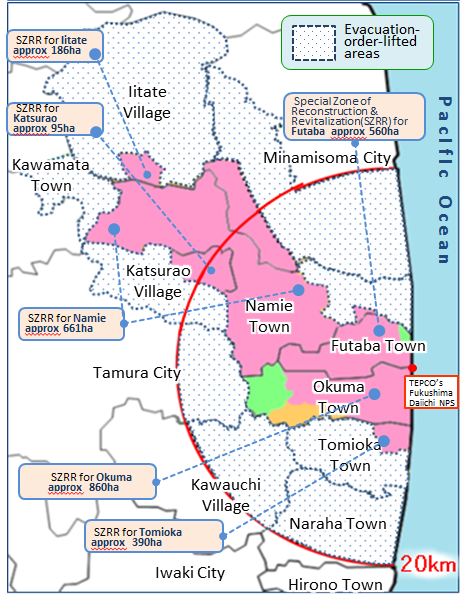
About Entrance and Stay in the evacuation designated zones (as of June 2015)

| Areas Designated According to Radiation Levels. | Entry restricted by physical barriers (e.g. barricades) |
Entry Points and Purposes of Entry | |||||
|---|---|---|---|---|---|---|---|
| Through traffic via Major Road | Temporary Return of Residents | Entry for Public Utilities | Entry for Work or Related Activities Permitted in Area | Overnight Stay in Area. | |||
 Difficult-to-Return Zone Difficult-to-Return Zone(Restricted Access Zone) |
Yes |  (Notes 1 & 2) |
 (Note 1) |
 (Note 1) |
 (Note 1) |
 |
|
 Restricted Habitation Zone Restricted Habitation Zone |
No |  |
 |
 |
 |
 (Note 3) |
|
 Preparatory Zone for lifting of Evacuation Order Preparatory Zone for lifting of Evacuation Order |
No |  |
 |
 |
 |
 (Note 3) |
|
Difficult-to-Return Zone (Restricted Access Zone)
The area where the annual cumulative dose estimated from the air dose rate may not be lower than 20 mSv, even 6 years after the nuclear disaster. (The area where the estimated annual cumulative dose exceeded 50 mSv as of March 2012)
Restricted Habitation Zone
The area where the annual cumulative dose estimated from the air dose rate has been confirmed to be above 20 mSv (as of March 2012).
Preparatory Zone for lifting of Evacuation Order
The area where the annual cumulative dose estimated from the air dose rate has been definitely confirmed as being below 20 mSv (as of March 2012).
The evacuation directives previously issued still remain in the all three areas, and in the "Difficult-to-Return Zone", entry is restricted by physical barriers (e.g., barricades).
In the "Restricted Habitation Zone" and the "Preparatory Zone for lifting of Evacuation Order", entry is restricted for other than non-authorized persons, although there is no day-time entry restriction.
(Note 1) It can be implemented when the municipality's mayor has issued a pass, etc.
(Note 2) For some main highways, travelers do not need to show their pass.
(Note 3) A system exists that allows for exceptions, such as an overnight stay in "special cases" or "when for preparing to return home".
Number of evacuees
| ◆ Nearly 43 thousand people from Fukushima continue to live as evacuees (Earthquake, Tsunami, NPS accident) |
|---|
Snapshot
October 2018 :Multipurpose Medical Helicopter started
| The Fukushima Prefectural Government is committed to assuring emergency medical services in Futaba district through the opening the Futaba Medical Centre-affiliated hospital (FMCH). For the further enforcement of emergency medical care in the district, operation of the multi-purpose medical helicopter started on October 2, 2018. Use of the multi-purpose medical helicopter for transportation of patients between medical institutes located in the coastal region and medical institutions such as Fukushima Medical University facilitates highly expertized treatment of the patient. This service will enable us to largely reduce emergency transportation time and will also prevent the increase in severity of the ailment while reducing the burden incurred during transportation. |
July 2018 :J-Village has restarted operation.
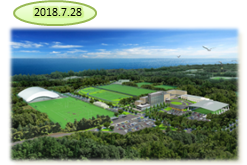 | J-Village which was suspended due to the nuclear accident, partially restarted its operation on July 28, 2018.The prefectural government will make use of J-Village as a symbol of revitalization to centralize and promote soccer and other sports as well as work to stop the spread of harmful-rumors generated in the wake of the nuclear disaster. J-Village will be an important platform from which the prefecture will be able to show the rest of Japan and the world its strong progress towards revitalization. |
April 2018 : Fukushima Prefectural Futaba Medical Center-affiliated hospital opens (Tomioka
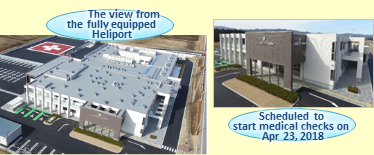 | In April, 2018, a hospital affiliated to Fukushima Prefectural Futaba Medical Center opened in Tomioka Town. The hospital provides 24/7/365 emergency medical services and will facilitate home medical checks and nursing care upon request from regional medical institutions. From a medical capacity it will also support the development of an environment where regional residents can live with a peace of mind; an environment where people engaged in the reconstruction projects can work without concern; and an environment where business entities can advance without anxiety. |
April 2018 : Elementary and Junior High Schools resume in local communities ( Odata district of Minamisoma City, Naraha Town, Yamakiya district of Kawamata Town, Tomioka Town, Katsurao Village, Iitate Village)
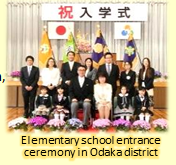 | Due to the aftermath of the nuclear power accident, Odaka districtof Minamisoma City and Naraha Town were forced to run elementary and junior high schools in Kashima district and Iwaki City respectively. In 2017, they returned to their towns and resumed school operations for the first time in six years. In April 2018 local schools are set to resume in the five municipalities:Yamakiya district in Kawamata Town, Tomioka Town, Namie Town, Katsurao Village and Iitate Village. The prefectural, municipal and national governments are united in their efforts to continue positive school development. . |
September 2017: Route 114 opened up to traffic
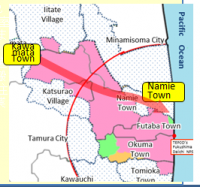 | On September 20, the previously closed Route 114 was re-opened to vehicle traffic. Route 114 runs for approximately 27km between Tsushima and Muroharain Namie Town. As this is a main road connecting Fukushima City with Namie Town, it is expected that it will make things more convenient for residents in Namie Town and adjacent municipalities as an evacuation route as well as a route for transportation of emergency goods and pesonnelin the event of a disaster. It's re-opening is expected to further accelerate restoration and reconstruction projects. |
July-August 2017: Opening of commercial facilities to support the reconstruction of the regions (Kawamata Town and Iitate Village).
| Commercial facilities which will support the reconstruction were opened in Yamakiya district, Kawamata Town and Iitate Village. These facilities aim to support the livelihoods of returnees, with retailers providing daily commodities, food, and places to eat. 'Tonya no Sato' or 'Home of Wholesalers' has an area devoted to providing information on the reconstruction efforts as well as a multi-purpose square. Madei Hall is a place where residents can meet and relax. Flowers are grown, displayed and sold in the building adding to the relaxed vibrant atmosphere. |
April 2017 : Elementary and Junior High Schools resumed for the first time in 6 years. (Odaka district of Minamisoma City)
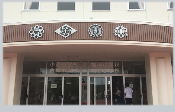 | Due to the aftermath of the nuclear power accident, Odaka district, Minamisoma City and Naraha Town were forced to run elementary and junior high schools in Kashima district and Iwaki City respectively. This year, they returned to their towns and resumed school operations for the first time in six years. Five municipalities (Kawamata Town, Yamakiya district, Tomioka Town, Namie Town, Katsurao Village and Iitate Village) are aiming to resume school operations in their hometowns. The prefectural government, municipalities and national government will continue to work together to form attractive schools. |
June 2017 : Groundbreaking of the Futaba Medical Center (tentative name) (Tomioka Town)
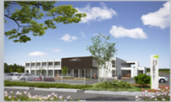 | On June 7, 2017, a ceremony to pray for the safety of construction and groundbreaking took place at the Futaba Medical Center (tentative name). We secured 24/7/365 emergency medical services and secondary emergency medical services including medical services to support resumption of home medical services that are required in the Futaba area and support "environment where local residents can work with peace of mind", "environment where people engaged in the revitalization projects can work with a sense of security", and "environment where companies can do businesses with security" from the medical aspect. Futaba Medical Center (tentative name) is expected to open in April, 2018. |
April 2017: Opening of Odaka Industrial Technology and Commerce High School (Minamisoma City)
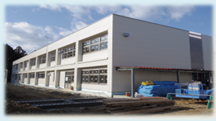 | In April 2017, Odaka Commerce High School will merge with Odaka Technology High School, as Odaka Industrial Technology and Commerce High School opens in Odaka, Minamisoma. It will train personnel who can contribute to regional reconstruction and the Fukushima Innovation Coast Framework. |
October-November 2016: Malls opened (Namie Town and Tomioka Town)
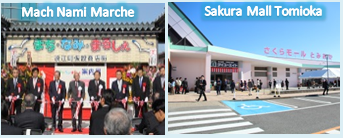 | On October 27, 2016, "Machi Nami Marche" was opened, and later on November 25, "Sakura Mall Tomioka" was opened. The openings were expected to improve convenience of residents returning home, in the perspective of lifting of evacuation orders in the future. |
Setting up *Futaba Medical Center (Tomioka Town) <*tentative name>
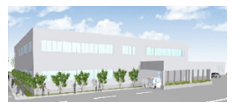 | The Prefectural Government will develop (tentative name) Futaba Medical Center in Ozukadistrict, Tomioka Town, in order to secure medical care necessary for the region including the secondary emergency medical care in Futaba county, and support an environment where residents and people engaged in revitalization projects can live and work with peace of mind, from a medical aspect. (scheduled to open in April, 2018) |
August 2016: Addressing to the resumption of J-Village (Hirono Town and Naraha Town)
| Fukushima Prefectural Government is addressing the recovery of J-Village which is under suspension due to the disaster. We are planning not only to restore the pre-disaster condition but also build a more attractive facility. For that, we are developing a new accommodation building with all weather training field in a scale of the whole soccer ground to partially resume the operation in summer of 2018 and fully resume in April, 2019. In 2020 Tokyo Olympic games, J-Village will be a training camp for representatives of Japanese male and female soccer players. We are reconstructing a new J-Village which will gain popularity among people as a symbol of revitalization of the prefecture. |
July 2016: JR Resumption of JR Joban Line between Haranomachi and Odaka
| On July 12, 2016, JR Joban Line resumed operation between Haranomachiand OdakaStation following the lifting of evacuation orders to MinamisomaCity. Many passengers took the train. In front of OdakaStation, a ceremony to pledge revitalization was organized by MinamisomaCity. JR Joban Line is expected to resume full lines by the end of March 2020. |
March 2016: Commercial complex. "Shopping Center YO-TASHI" opened
| On March 15, 2016, a commercial complex "Shopping Center YO-TASHI" was opened in KawauchiVillage, housing Family Mart Kawauchithat sells fresh food, a pharmacy, a cleaning store, and restaurants. There is a community space available for exchanges between villagers. This is expected to facilitate residents' return and revitalization as well as recovery of the community after their return. |
March 2016: Naraha Remote Technology Development Center (Mock-up Center) Test Facility completed
| On March 30, 2016, a completion ceremony was held for a test facility of the NarahaRemote Technology Development Center constructed by the Japan Atomic Energy Agency (JAEA). The facility is equipped with a mock-up of a part of a nuclear reactor containment vessel, and serves as a hub of decommissioning research by TEPCO. Full operation started from April. |
February 2016: Revitalization clinic ‘FUTABA RE-CARE’ opens, Naraha town
 | On Feb 1, 2016, the new clinic is established in NarahaTown in order to help the recovery of Futaba County and develop an environment for the return of residents. |
December 2015: Mega solar power plant starts operation, Okuma town
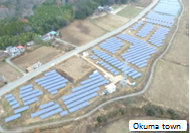 | Okuma Town FurusatoRevitalization Mega Sola Power Plant was completed in Okawaradistrict which is a hub of reconstruction for Okuma Town, and started operation from December 18, 2015. Annual output is about 2,200MWh that covers power consumption by about 600 households. Part of sales revenue of electricity is being used for the operation of plant factory to be constructed in Okawaradistrict by Okuma Town. |
November 2015: Special Elderly Nursing Home opens, Kawauchi village
 | The home newly established and opened in KawauchiVillage on 1 November, 2015 has 80 beds available |
April 2015: Futaba Future School Opens, Hirono town
 | On April 8, 2015, a new public school opened as a 6-year secondary education school in HironoTown. The school is aimed to become a symbol of revitalization of the prefecture through its own curriculum to grow human resources who will contribute to global and future society. |



